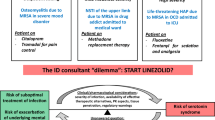Abstract
The aim of this study was to define the structural characteristics in a series of 21 analogues of the antihistaminergic drug diphenhydramine which are important for the interaction with cytochrome P-450. The compounds gave substrate (type I) binding spectra with rat hepatic microsomal cytochrome P-450. The main findings were: (1) two phenyl rings are needed for strong binding: saturation or elimination of one ring, or restriction of two phenyls with a two-carbon bridge results in a decrease of binding, (2) substitution on one or both aromatic rings has only a small influence on binding, (3) an amine nitrogen contributes to better binding; decrease or absence of basicity weakens binding, and (4) a chain of 4 to 7 atoms connecting the basic centre with the aromatic part is needed; reduction of the chain length, or restriction of it to a cyclic structure causes decrease or loss of binding ability.
Similar content being viewed by others
References
C. Repond, A. Bulgheroni, U. A. Meyer, and B. Testa,Dual ligand binding of pyridylalkanamides to microsomal cytochrome P-450. Biochem. Pharmacol.35, 2233–2240 (1986).
B. Testa and P. Jenner,Inhibitors of cytochrome P-450s and their mechanism of action. Drug Metab. Rev.12, 1–17 (1981).
B. Lindeke, U. Paulsen-Sorman, G. Hallstrom, A. H. Khuthier, A. K. Cho and R. C. Kammerer,Cytochrome P-455-nm complex formation in the metabolism of phenylalkylamines. Drug Metab. Disp.10, 700–705 (1982).
D. R. Petzold, H. Rein, D. Schwartz, M. Sommer and K. Ruckpaul,Relation between the structure of benzphetamine analogues and their binding properties to cytochrome P-450 LM2. Biochim. biophys. Acta829, 253–261 (1985).
P. R. Andrews, D. J. Craik and J. L. Martin,Functional group contributions to drug-receptor interactions. J. med. Chem.27, 1648–1657 (1984).
A. Bast and J. Noordhoek,Calculation of competitive inhibition of substrate binding to cytochrome P-450, illustrated by the interaction of d,l-propranolol with d,l-hexobarbital. Biochem. Pharmacol.29, 747–751 (1980).
M. Murray,Mechanisms of the inhibition of cytochrome P-450-mediated drug oxidation by therapeutic agents. Drug Metab. Rev.18, 55–81 (1987).
A. Bast, F. A. A. van Kemenade, E. M. Savenije-Chapel and J. Noordhoek,Product inhibition in orphenadrine metabolism as a result of a stable cytochrome P-450-metabolic intermediate complex formed during the disposition of mono-N-desmethyl-orphenadrine (tofenacine) in the rat. Res. Comm. Chem. Path. Pharmacol.40, 391–403 (1983).
M. Rossi, S. Markovitz and T. Callahan,Defining the active site of cytochrome P-450: the crystal and molecular structure of an inhibitor, SKF-525 A. Carcinogenesis,8, 881–887 (1987).
W. Schwartze, J. Jaeger, G. R. Jänig and K. Ruckpaul,Active site model of cytochrome P-450 LM2. Biochem. biophys. Res. Comm.150, 996–1005 (1988).
T. L. Poulos, B. C. Finzel, I. C. Gunsalus, G. C. Wagner and J. Kraut,The 2.6 A crystal structure of Pseudomonas putida cytochrome P-450. J. biol. Chem.260, 16122–16130 (1985).
Author information
Authors and Affiliations
Rights and permissions
About this article
Cite this article
Rekka, E., Timmermann, H. & Bast, A. Structural features of some diphenhydramine analogues that determine the interaction with rat liver cytochrome P-450. Agents and Actions 27, 184–187 (1989). https://doi.org/10.1007/BF02222234
Issue Date:
DOI: https://doi.org/10.1007/BF02222234




